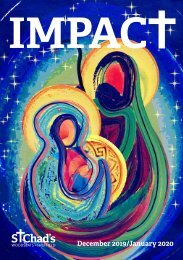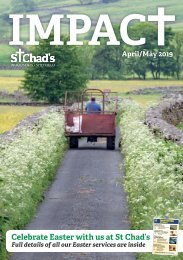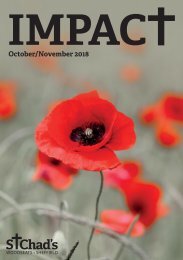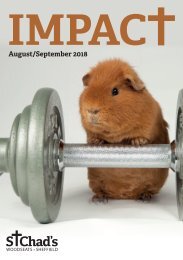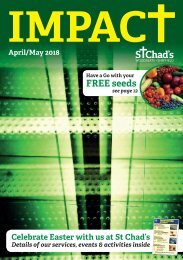Impact0420
The April/May 2020 edition of Impact. Please be aware that due to the coronavirus pandemic and lockdown measures, many of the services, events and activities listed in this edition will no longer be taking place.
The April/May 2020 edition of Impact.
Please be aware that due to the coronavirus pandemic and lockdown measures, many of the services, events and activities listed in this edition will no longer be taking place.
You also want an ePaper? Increase the reach of your titles
YUMPU automatically turns print PDFs into web optimized ePapers that Google loves.
The tradition of Pace Eggs
I
was brought up in
Northumberland and would
make ‘Pace Eggs’ at Easter.
This is a rural tradition
mainly in Lancashire, West
Yorkshire and the North. The
name comes from the Latin
‘pascha’ which means Easter.
The eggs are decorated,
boiled in natural or man made
dyes and then can be eaten on
Easter morning, given to friends
or rolled down hills on Easter
Monday in a competition. The
egg which was least cracked
and rolled the furthest won. We
would often keep the prettiest
eggs and, providing they were not
cracked and going smelly, would
eventually dry and last for years. I
still have one from my childhood.
Traditionally the eggs would be
wrapped in the outside skins of
onions, covered with fine cloth
and cotton and boiled. This gives
a mottled brown and yellow egg.
We used water soluble glue and
stuck leaves and flowers to the
egg, some flowers like gorse
would dye yellow, fine leaves like
cow parsley and small flowers
like celandines coming out at
Easter time make good shapes.
We would hunt the garden for
the earliest flowers. and boiled in
artificial dyes until hard-boiled and
cooled slowly. There was always
excitement when unwrapping the
eggs to see what had made the
best patterns. Where the leaves
and flowers were there would be
less dye.
Natural dyes can be made with
things like turmeric (boiling for 30
minutes will give deep gold eggs).
Red cabbage will give surprisingly
blue eggs. Beetroot will give light
pink eggs and black coffee dark
brown eggs.
The significance of eggs at
Easter is of new life of a chick
breaking out of the shell like
Jesus Christ burst out of
the tomb on Easter day.
There has been a
revived tradition in the
North of Pace Egg
plays, originally like
Mummers plays.
This involves a
mock combat
between a hero
and a villain in
which the hero is
killed and has to
be bought back to
life. This mirrors the
Easter message of
Jesus’ sacrifice on the
cross and resurrection.
Rabbits have nothing to
do with Easter in my mind.
Toria Karney
St Chad’s Church, Linden Avenue, Woodseats
Church Office: Linden Avenue, Sheffield S8 0GA
Tel: (0114) 274 5086
Page 10
email: office@stchads.org
website: www.stchads.org





